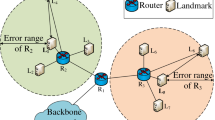Abstract
Although many classical IP geolocation algorithms are suitable to rich-connected networks, their performances are seriously affected in poor-connected networks with weak delay-distance correlation. This paper tries to improve the performances of classical IP geolocation algorithms by finding rich-connected sub-networks inside poor-connected networks. First, a new delay-distance correlation model (RTD-Corr model) is proposed. It builds the relationship between delay-distance correlation and actual network factors such as the tortuosity of the network path and the ratio of propagation delay. Second, based on the RTD-Corr model and actual network characteristics, this paper discusses about how to find rich-connected networks inside China Internet which is a typical actual poor-connected network. Then we find rich-connected sub-networks of China Internet through a large-scale network measurement which covers three major ISPs and thirty provinces. At last, based on the founded rich-connected sub-networks, we modify two classical IP geolocation algorithms and the experiments in China Internet show that their accuracy is significantly increased.
Similar content being viewed by others
References
Jia M, Zhu Y, Yang H. An IP geolocation algorithm using band-width measurement and distance estimation [C] // Proceedings of the 2015 International Conference on Electrical and Information Technologies for Rail Transportation. Berlin, Heidelberg: Springer-Verlag, 2016: 519–527.
Lee Y, Park H, Lee Y. IP geolocation with a crowd-sourcing broad-band performance tool[J]. ACM SIGCOMM Computer Communication Review, 2016, 46(1): 12–20.
Liu H, Zhang Y, Zhou Y, et al. Mining checkins from location-sharing services for client-independent IP geolocation [C] // Proceedings of IEEE INFOCOM. Toronto: IEEE Press, 2014: 619–627.
Wang Y, Burgener D, Flores M, et al. Towards street-level client-independent IP geolocation[C]// Proceeding of the 8th USENIX Conference on Networked Systems Design and Implementation. New York:ACM Press, 2011:27–42.
Poese I, Uhlig S, Kaafar M, et al. IP geolocation databases: Unreliable?[J]. ACM SIGCOMM Computer Communication Review, 2011, 41(2): 53–56.
Shavitt Y, Zilberman N. A geolocation databases study[J]. IEEE Journal on Selected Areas in Communications, 2011, 29(10): 2044–2056.
Guo C, Liu Y, Shen W, et al. Mining the web and the internet for accurate IP address geolocations [C] // Proceedings of IEEE INFOCOM. Toronto: IEEE Press, 2009: 2841–2845.
Katz-Bassett E, John J P, Krishnamurthy A, et al. Towards IP geolocation using delay and topology measurements [C] // Proceedings of the 6th ACM SIGCOMM Conference on Internet Measurement. New York:ACM Press, 2006: 71–84.
Padmanabhan V N, Subramanian L. An investigation of geographic mapping techniques for internet hosts[J]. ACM SIGCOMM Computer Communication Review, 2001, 31(4): 173–185.
Gueye B, Ziviani A, Crovella M, et al. Constraint-based geolocation of internet hosts[J]. IEEE/ACM Transactions on Networking, 2006, 14(6): 1219–1232.
Li D, Chen J, Guo C, et al. IP-geolocation mapping for moderately connected internet regions[J]. IEEE Transactions on Parallel and Distributed Systems, 2013, 24(2): 381–391.
Wang Y, Lai P, Sui D. Mapping the internet using GIS: The death of distance hypothesis revisited [J]. Journal of Geographical Systems, 2003, 5(4):381–405.
Ziviani A, Fdida S, De R, et al. Toward a measurement-based geographic location service [C] // Proceedings of ACM Conference on Passive and Active Measurements. Berlin, Heidelberg:Springer-Verlag, 2004: 43–52.
China Internet Society. The Development Report of China Internet 2015 [M]. Beijing: Publishing House of Electronic Industry, 2013(Ch).
Tian Y, Dey R, Liu Y, et al. Topology mapping and Geolocating for China’s Internet [J]. IEEE Transactions on Parallel and Distributed Systems, 2013, 24(9): 1908–1917.
Vincenty T. Direct and inverse solutions of geodesics on the ellipsoid with application of nested equations [J]. Survey Review, 1975, 23(176): 88–93.
Author information
Authors and Affiliations
Corresponding author
Additional information
Foundation item: Supported by the National Natural Science Foundation of China (61379151, 61274189, 61302159 and 61401512), the Excellent Youth Foundation of Henan Province of China (144100510001) and Foundation of Science and Technology on Information Assurance Laboratory ( KJ-14-108)
Biography: DING Shichang, male, Ph.D. candidate, research direction: IP geolocation.
Rights and permissions
About this article
Cite this article
Ding, S., Luo, X., Ye, D. et al. Delay-distance correlation study for IP geolocation. Wuhan Univ. J. Nat. Sci. 22, 157–164 (2017). https://doi.org/10.1007/s11859-017-1229-2
Received:
Published:
Issue Date:
DOI: https://doi.org/10.1007/s11859-017-1229-2
Key words
- IP geolocation
- delay-distance correlation
- network security
- network measurement
- rich-connected sub-networks




